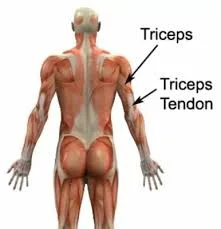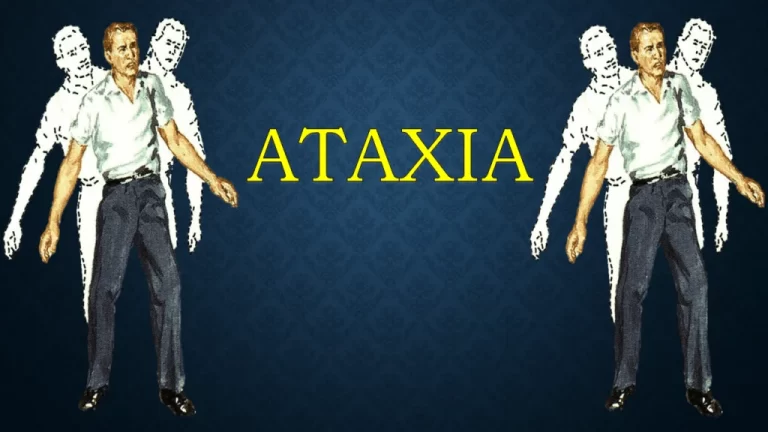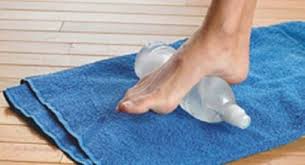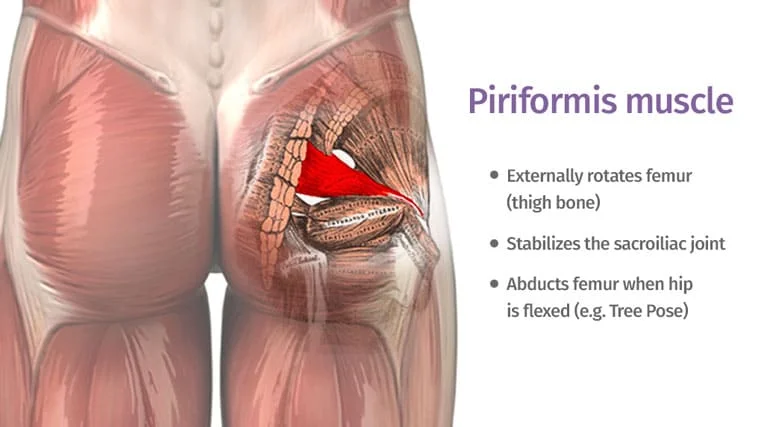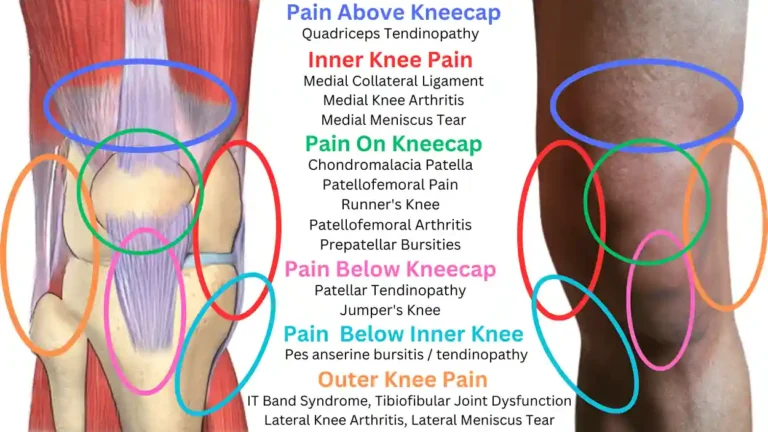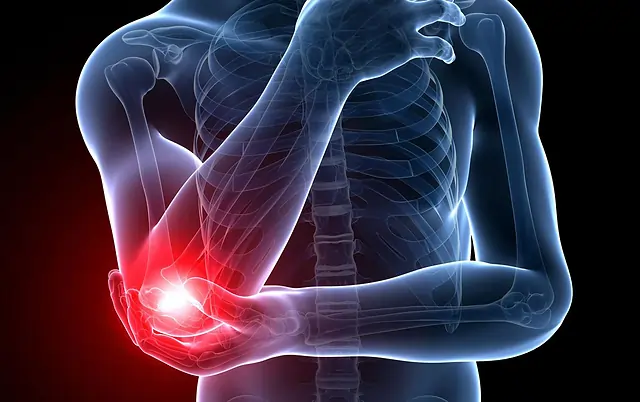Triceps Tendonitis
Triceps Tendonitis: What is it?
Triceps tendonitis, also known as tricep tendinitis, is characterized by inflammation and irritation of the triceps tendon. The triceps tendon is a thick band of connective tissue that connects the triceps muscle on the back of the upper arm to the olecranon, which is the bony prominence at the tip of the elbow.
When the triceps muscles are used excessively or repetitively, tendonitis develops, which can cause minor rips or damage to the tendon. This can result from repetitive arm movements, such as weightlifting, throwing, or sports like tennis and golf. It is also common among individuals who engage in activities that require frequent overhead arm movements.
The most typical signs of triceps tendonitis are elbow, shoulder, or triceps pain and weakness. Pain frequently worsens when using the triceps, such as when pressing with the arm. There may also be elbow, triceps, or shoulder aches.
Injuries to the triceps tendon are an uncommon clinical issue rarely discussed in the literature.
Rest, ice, immobilization, nonsteroidal anti-inflammatory drugs, and physical therapy are conservative treatment options for partial tendon tears and triceps tendinopathies with retained strength.
If conservative treatment is unsuccessful for six months or if an examination shows weakness deficits, surgery should be considered.
Anatomy of Triceps Muscle:
The triceps brachii, also known as just the triceps, is the name of the big muscle on the rear of the upper arm. It is in charge of straightening the arm by extending the elbow joint. In the muscles of the triceps muscle, there are three heads:
Long head: The scapula’s (shoulder blade) infraglenoid tubercle is the source of this head. The only head that crosses the elbow and shoulder joints is this one.
The lateral head is located above the radial groove on the posterior aspect of the humerus, or upper arm bone.
Medial head: This head, which lies beneath the radial groove, likewise comes from the humerus’s posterior surface.
The triceps muscle’s three heads unite to form a single tendon that attaches to the ulna’s (one of the forearm bones) olecranon process.
Functions:
In contrast to the biceps brachii muscle, the triceps muscle is principally in charge of extending the forearm at the elbow joint. Additionally, it aids in elbow joint stability when performing delicate tasks like writing.
The radial nerve innervates the triceps muscle.
Causes of Triceps Tendonitis:
Tendonitis in the triceps is common in people who lift weights or play particular sports regularly. People who start a sport or fitness program and start exercising excessively too soon are also often affected by this illness. Your body is telling you that a muscle has been overworked. Rather than occurring suddenly, tricep tendonitis develops gradually.
Tricep tendinitis is frequently caused by the following factors:
- Tricep tendon extension or overuse regularly.
- Forceful motions, such as pounding or bench pressing.
- Actions that aren’t typical of the body, such as excessive arm extension.
- Inadequate technique or form when engaging in physical exercise.
- Quick, sharp motions.
Rheumatoid arthritis and diabetes are two other illnesses that can cause tendinitis.
Signs and Symptoms of Triceps Tendonitis:
Pain and soreness in the rear of the elbow, close to the tip, which may spread down the back of the arm, are the main signs of triceps tendonitis. Moving your arms or applying pressure to the affected area may make the discomfort worse. There may occasionally be edema or a warm feeling around the elbow.
Some indicators that you may develop triceps tendonitis include the following:
- Soreness in the triceps, shoulder, or elbow muscles is what you’re experiencing.
- The discomfort you feel when you work on your triceps.
- Your arm’s range of motion is limited.
- A lump or swollen area directly above the elbow on the back of your upper arm.
- Weakness in your triceps, elbow, or shoulder.
- A popping noise or feeling right after being hurt.
Diagnosis:
Your doctor will ask you about your symptoms and the onset of your discomfort before making the diagnosis of tricep tendonitis. They may assess your range of motion and apply pressure to specific parts of your arm to see whether they hurt.
They may prescribe tests to examine the condition within your arm and look for infections or other problems if they believe you may have tricep tendonitis. These examinations could consist of:
- Ultrasounds
- X-rays and magnetic resonance imaging (MRI) to examine the nearby bones
- Aspirations of the joints to check for infection
To help with the discomfort and swelling, your doctor may suggest a nonsteroidal anti-inflammatory medicine (NSAID), such as naproxen or ibuprofen. NSAID creams, which are applied topically to the area, can also help with pain.
Following these therapies, your doctor may suggest a steroid injection if your symptoms don’t get better. In rare circumstances, you might need surgery.
Treatment of Triceps Tendonitis:
To promote healing and stop the problem from getting worse, early diagnosis and suitable treatment are essential. In the early stages of triceps tendonitis, RICE (rest, ice, compression, and elevation) is frequently advised to relieve pain and reduce inflammation. Avoiding activities that make the discomfort worse and taking anti-inflammatory drugs may also help.
- R: Rest: Stay Away from activities or movements that could further injure or exacerbate your triceps tendon.
- I- Ice: Apply ice to the affected area for 20 minutes or so, several times a day, to lessen pain and swelling.
- C: Compression: Use bandages or wraps to compress and support the area until edema has subsided.
- E-Elevate: Maintain the affected area above the level of your heart to minimize swelling.
Drugs:
Corticosteroids Injections:
Corticosteroid injections can help reduce pain and edema. The drug will be injected by your physician into the region surrounding your triceps tendon.
For tendonitis that has lasted more than three months, this treatment is not recommended since repeated steroid injections may weaken the tendon and increase the risk of further damage.
Platelet-rich plasma (PRP) Injection:
Your physician may suggest a platelet-rich plasma (PRP) injection for your tendonitis. The platelets and other blood components that aid in healing are isolated from a sample of your blood during PRP.
This solution is then injected into the area around your triceps tendon. The injection may help by providing nutrients to hasten the healing process because tendons have a poor blood supply.
Physical therapy:
Modalities:
- Laser therapy and electric shock (IFT, TENS)
Physical therapy may also be used to treat your triceps tendonitis. It focuses on strengthening and increasing the flexibility of your triceps tendon through a regimen of targeted workouts.
Here are some simple exercises you could attempt. Before starting any of these workouts, don’t forget to consult your doctor because performing certain exercises too soon after an accident could make your condition worse.
Bending and straightening the elbow:
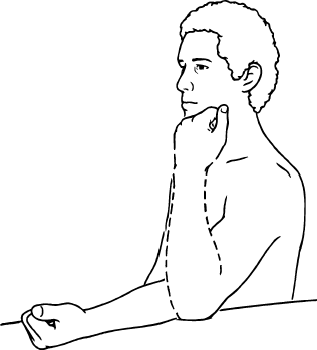
- Keep your hands by your sides in a loose fist.
- Your hands should be at shoulder height or higher.
- Drop your hands slowly while keeping your elbows straight after you have them back at your sides.
- Stop after ten to twenty times.
The French stretch
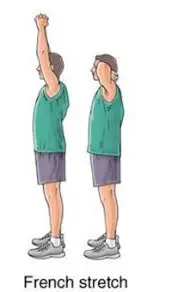
- Standing, clasp your hands together and raise them above your head.
- Keeping your hands clasped and your elbows close to your ears, drop your hands behind your head as you attempt to touch your upper back.
- For fifteen to twenty seconds, maintain the posture decreased.
- Three to six times.
Static triceps stretch:
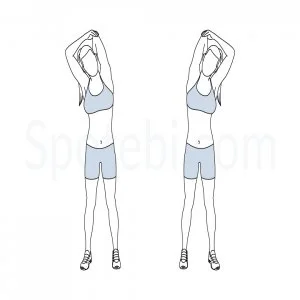
- At the elbow, your injured arm should be 90 degrees bent. In this position, your hand should be in a fist with the palm facing inward.
- Press down with the fist of your bent arm on the open palm of your other hand to tighten the triceps muscles at the back of your injured arm.
- Hold for five seconds.
- Tighten your triceps 10 times as much as you can without feeling uncomfortable.
Towel resistance:
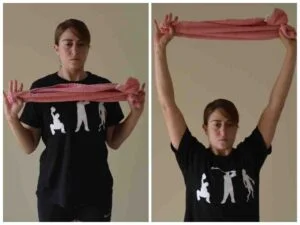
- Hold one end of a towel in each of your hands.
- Place the damaged arm behind your back and the uninjured arm over your head while you are standing.
- With the other hand, gently pull the towel down while you raise your injured arm towards the ceiling.
- Hold the position for 10 seconds.
- Ten times overall.
Triceps kickback
- Leaning forward and supporting oneself with a table or chair under the hand of one arm.
- Place the right foot on a step or platform, place the right forearm on the thigh, or let the arm drop just below the shoulder to support the back.
- Using your left hand to hold a weight, raise your elbow to body level.
- Focus on strengthening your triceps muscle as you extend your arm behind you while maintaining that elbow position.
- Maintain this posture for a short while.
- Reduce the forearm’s angle to around 90 degrees.
- Then return to your neutral position.
- Then unwind.
- Do this exercise five to ten times.
- Maintain the immobility of your upper arms against your body throughout the exercise.
Bench Tricep Dips
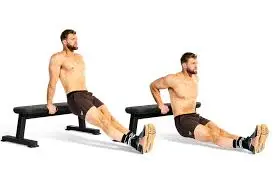
- Place two flat benches parallel to each other and three to four feet apart.
- Sitting on one bench and facing the other, place your hands on the side of the bench.
- Using your hands to support your weight, raise your feet to the top of the other bench, leaving the rest of your body hanging.
- The two benches are on the other side.
- Stretch one foot over the other.
- To get your forearms and upper arms at a straight angle, progressively bend your elbows towards the floor.
- Avoid bending your shoulders below a 90-degree angle since this can cause tension.
- Then return to your neutral position.
- Then unwind.
- Do this five to ten times.
Supine Triceps Extension
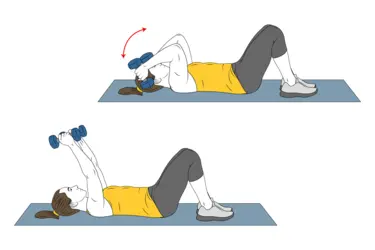
- Lay flat on a table or bed to start.
- With your feet firmly planted on the floor, rest your head on the bed.
- Raise a dumbbell over your shoulders at arm’s length in each hand.
- Lower the dumbbells until you are in a comfortable position while bending your elbows.
- Slowly return to the beginning position.
- Hold this position for a short time.
- Going back to the starting position.
- Then relax.
- Do this exercise five to ten times.
Overhead Tricep Extension
- Begin by standing in a comfortable position.
- Keep your back straight.
- Hold a weight in the air with both hands.
- Lower the weight until your elbows are at a 90-degree angle behind your head while maintaining your biceps near your ears.
- Tighten your triceps and straighten your arms.
- Then return to your neutral position.
- Then unwind.
- Do this exercise five to ten times.
- Keep your core tight and refrain from arching your back during the workout.
Surgery:
It is advised to treat triceps tendonitis with more conservative measures such as physical therapy, medicine, and rest.
However, if the damage is severe or if other therapies have not worked, surgery might be required to repair your torn triceps tendon. This is often recommended in cases where the tendon is partially or completely torn.
Repairing tendons:
The purpose of triceps tendon repair is to reattach the damaged tendon to the elbow’s olecranon. The olecranon is located in the ulna, one of the long bones of your forearm. Usually, the entire treatment is performed under general anesthesia, which puts you to sleep.
The wounded arm is immobilized while an incision is made. Following appropriate exposure of the injured tendon, sutures are used to connect it to the olecranon by inserting bone anchors or suture anchors into the bone.
For a precise diagnosis and a customized treatment plan depending on the severity of the triceps tendonitis and the demands of the individual, it is imperative to speak with a healthcare provider. Targeted rehabilitation exercises, adequate rest, and early intervention can greatly enhance the outcome and enable people to resume their normal activities pain-free.
Tips for Avoiding Tricep Tendonitis:
There are precautions you may take to reduce your risk of tendinitis, even if there is no surefire method to avoid it.
Get warm-up. Your risk of injury is reduced and blood flow is increased as you warm up your muscles.
Execute workouts properly. Spend some time learning how to perform exercises correctly. This lowers your chance of getting hurt and improves your performance.
Avoid overstretching yourself. Excessive exercise on fatigued muscles might result in tendinitis and larger muscular tears.
When to Consult a Physician:
It could be necessary to see a doctor if your symptoms don’t go away after three days of rest. Additional indicators that you should consult a physician include:
- An ongoing redness and swelling of the tendon
- Severe discomfort and pain
- Limitations in movement and symptoms that worsen even after rest
Home Treatments:
Resting the affected tendon for up to three days can help treat some types of tendonitis at home. You can attempt the following while your muscles are at rest:
- Prevent from moving. For two to three days, avoid moving your arm or tricep. As much as possible, rest it and avoid moving it.
- Ice the area. Place a bag of frozen peas or a bag of ice wrapped in a towel on the tendon. Every three hours, leave it there for twenty minutes.
- Get ready. To support the muscle, try applying a supportive bandage or brace. The support should fit comfortably without being too tight. Before you go to bed, take it off.
Until the tendon has completely healed and the discomfort has subsided, avoid making any sharp or violent motions again.
Summary:
Triceps tendonitis most commonly manifests as elbow, shoulder, or triceps pain and weakness. Pain usually worsens when using the triceps, like when pressing or using the arm. There may also be elbow, triceps, or shoulder aches.
Injuries to the triceps tendon are an uncommon clinical issue rarely discussed in the literature. Treatment for triceps tendinopathies depends on the mechanism of damage and the patient’s motor evaluation.
Rest, ice, immobilization, nonsteroidal anti-inflammatory drugs, and physical therapy are conservative treatment options for partial tendon tears and triceps tendinopathies with retained strength.
If conservative treatment is unsuccessful for six months or if an examination shows weakness deficits, surgery should be considered. Based on the data that is now available, the “best” surgical technique is still unclear.
FAQs
What is the treatment for tricep tendonitis?
Rest, ice, immobilization, nonsteroidal anti-inflammatory drugs, and physical therapy are conservative treatment options for partial tendon tears and triceps tendinopathies with retained strength. If conservative treatment is unsuccessful for six months or if an examination shows weakness deficits, surgery should be considered.
How long does it take to heal from tricep tendonitis?
Since most occurrences of triceps tendonitis are treated non-operatively, the tendon usually heals in four to six weeks. Athletes can also assist prevent further injuries by warming up correctly before play and applying ice to the damaged elbow if it hurts after exercise.
Is it possible to reverse tricep tendonitis?
In many cases, triceps tendonitis can be resolved with rest alone. Sometimes medication is required to treat the pain.
Could you work out if you have tendinitis in your back arm muscles?
First and foremost, the guilty movement should be avoided, changed, or lessened. We advise weightlifters, for example, to use a lesser weight when performing shoulder and bench presses, which are popular pressing exercises done in the gym. Occasionally, switching up shoulder and chest exercises can be beneficial.
Is heat a good treatment for tendinitis in the back of the arm?
For persistent tendon discomfort, sometimes referred to as tendinopathy or tendinosis, heat may be more helpful. Because heat can enhance blood flow, it may help mend tendons. Additionally, heat relaxes muscles, which helps ease pain.
Which workouts are best for treating triceps tendonitis?
Exercises for flexibility, stretching, and joint strength.
These exercises include push-ups, plank triceps kickbacks, alternating dumbbell floor presses, dumbbell overhead shoulder presses, and elbow bending and straightening.
How long does tendinitis last?
While persistent tendinitis takes about six weeks to recover, the most common type of tendonitis usually goes away in one to three weeks.
Does tendinitis benefit from exercise?
Start working out to strengthen the muscles surrounding the aching joint within a day or two. A lengthy warm-up should be performed first to lessen tissue shock. Next, try lifting little weights or using an elastic training band.
References
- What to know about tricep tendonitis. (n.d.). WebMD. https://www.webmd.com/fitness-exercise/what-to-know-about-tricep-tendonitis
- Patel, D. (2023d, December 13). Triceps tendonitis – Cause, symptoms, treatment, exercise. Mobile Physiotherapy Clinic. https://mobilephysiotherapyclinic.in/triceps-tendonitis-treatment/
- Bariya, D. (2023, December 13). 26 Best exercise for triceps tendonitis – Mobile Physio. Mobile Physiotherapy Clinic. https://mobilephysiotherapyclinic.in/26-best-exercise-for-triceps-tendonitis/
- Seladi-Schulman, J., PhD. (2019, April 22). How to treat triceps tendonitis. Healthline. https://www.healthline.com/health/sports-injuries/tricep-tendonitis

